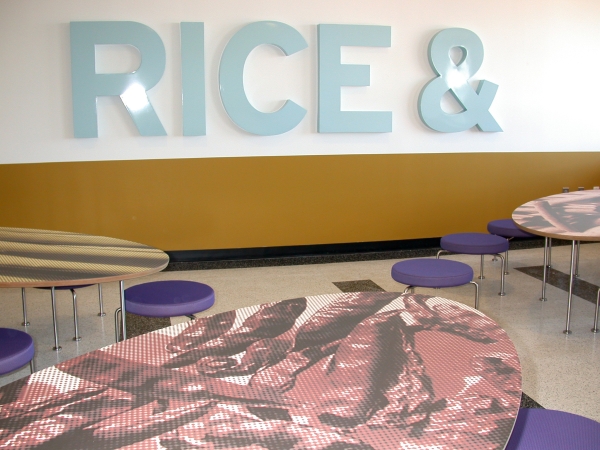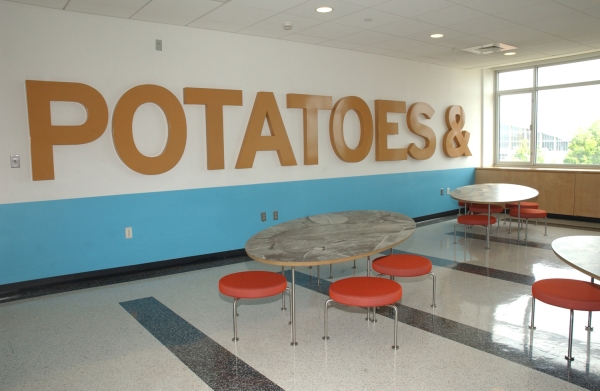
Material tests
Construction drawing of oval table in collaboration with Fernlund/Logan Architects, New York
Spice up Powdermaker
Since 2003, permanent
Powdermaker Hall, Social Sciences, Queens College, New York
Ground Floor:
– “Corn &,” 2003, letters made of steel and porcelain enamel; height: 39 inches
– Wall painting
– Three tables, rust-free steel, finply, laminate, printed; 24 x 94 x 47 inches
First Floor:
– “Potatoes &,” 2003, letters made of steel and porcelain enamel; height: 39 inches
– Wall painting
– Four tables, rust-free steel, finply, laminate, printed; 24 x 94 x 47 inches
Second Floor:
– “Rice &,” 2003, letters made of steel and porcelain enamel; height: 39 inches
– Wall painting
– Four tables, rust-free steel, finply, laminate, printed; 24 x 94 x 47 inches
With a total of 60 stools with different coverings
Queens College, part of the City University of New York (CUNY), commissioned Christian Philipp Müller to develop a permanent, site-specific work for the renovated and expanded Powdermaker Building, the main campus building. In parallel with three other invited artists, Julie Ault, Frank Gohlke, and Joel Sternfeld, Müller initiated his work, “Spice up Powdermaker,” in the building of the Sociology Department. As of September 2004, the three-part work was permanently installed in three student lounges on different floors. The piece consists of a total of eleven oval tables and stools, constructed from different resting surfaces and made of wood veneer set on top of steel frames. At each entrance, letters made from porcelain enamel announce the themes introduced in each room.
In 2002/03 Müller had organized a seminar on campus about the politics of nutrition together with Maureen Connor. He asked the mixed, heterogeneous body of students to bring in recipes from their families and their countries of origin, and out of the overlaps and differences that emerged, he compiled the motifs of his work. Each lounge has a different color scheme related to the nutritional theme. On each floor, an enamel porcelain sign at the entrance indicates a basic nutritional staple. On the first floor it reads, “Corn &,” on the second, “Potatoes &,” and on the third, “Rice &.”
The signs form a cross-section of the assembled materials, recipes, and conversations, and determine the color aesthetic of the space. In the corn room, the gold-yellow sign has been attached over an orange wall. The stool and the oval tabletop are colored in two different olive tones, and their surfaces are covered with enlarged illustrations of tamarind, porcini mushrooms, and black chili peppers, spices that are added to fundamental nutritional staples from different cultures. This concept is repeated on all floors, in brown and blue (potatoes) and in blue and dark orange (rice). Müller designed the tables for the project together with the designers of the stools, Neil Logan and Solveig Fernlund. This work, based on the experiences of the students, does not convey an exoticism that distances cultures; instead, it evokes a sense of community in which the interface of the cuisine from different countries serves as the underlying idea for communal space.





